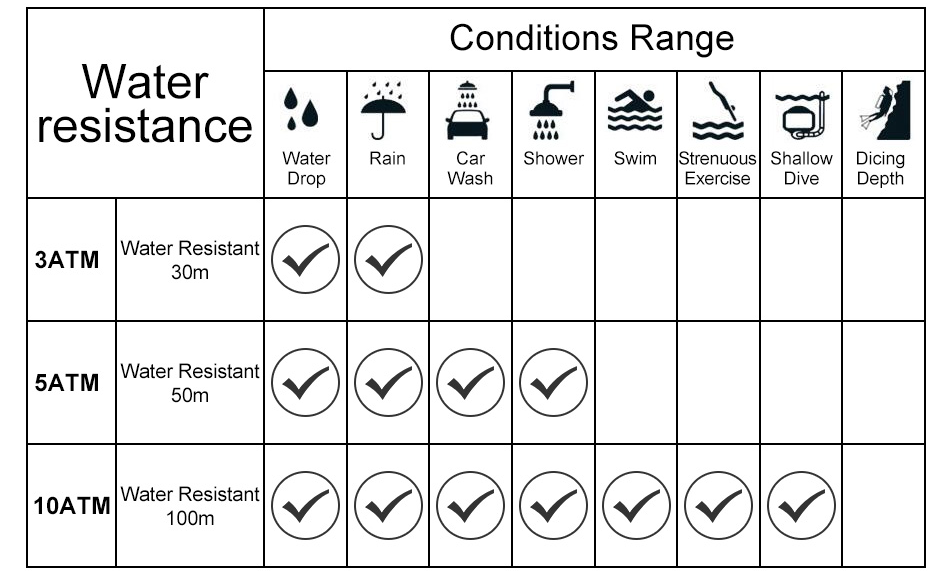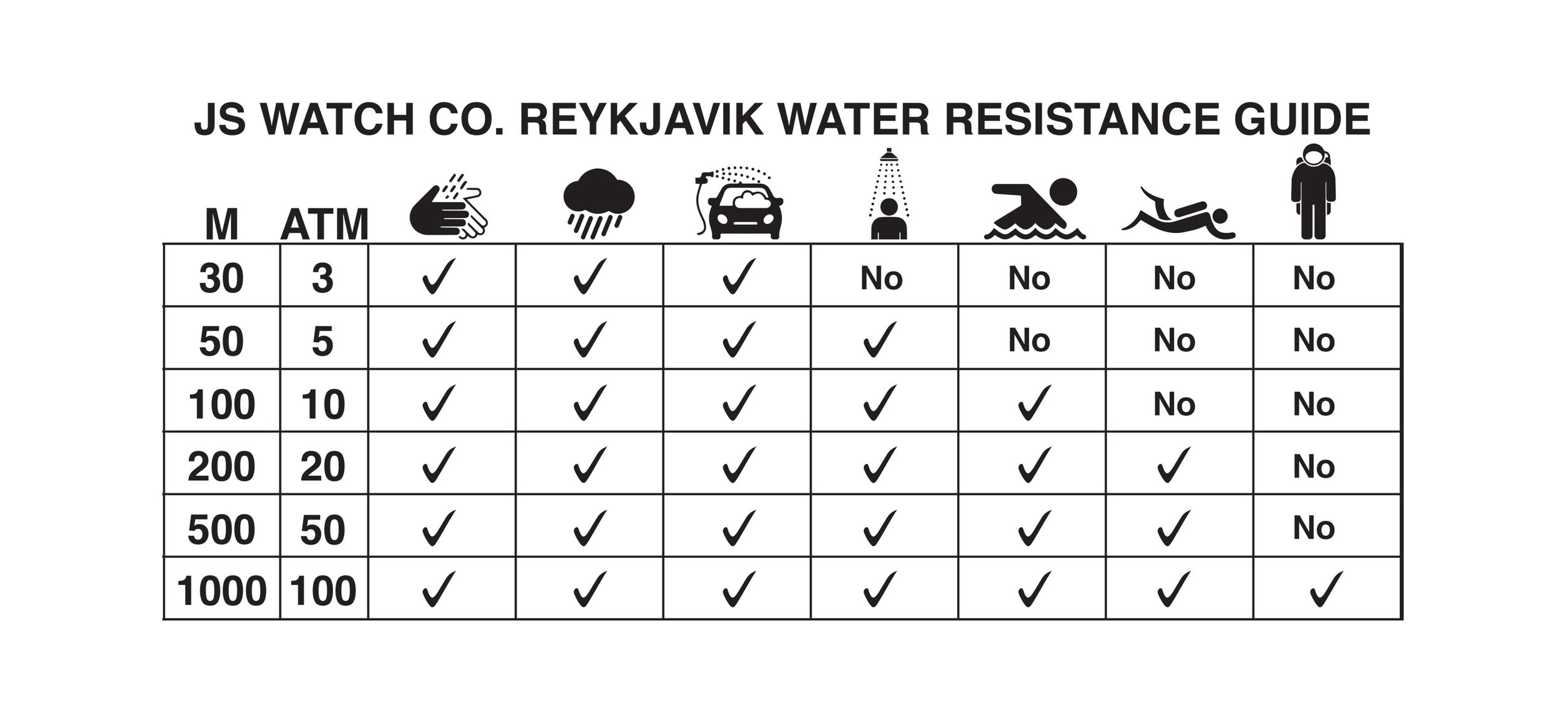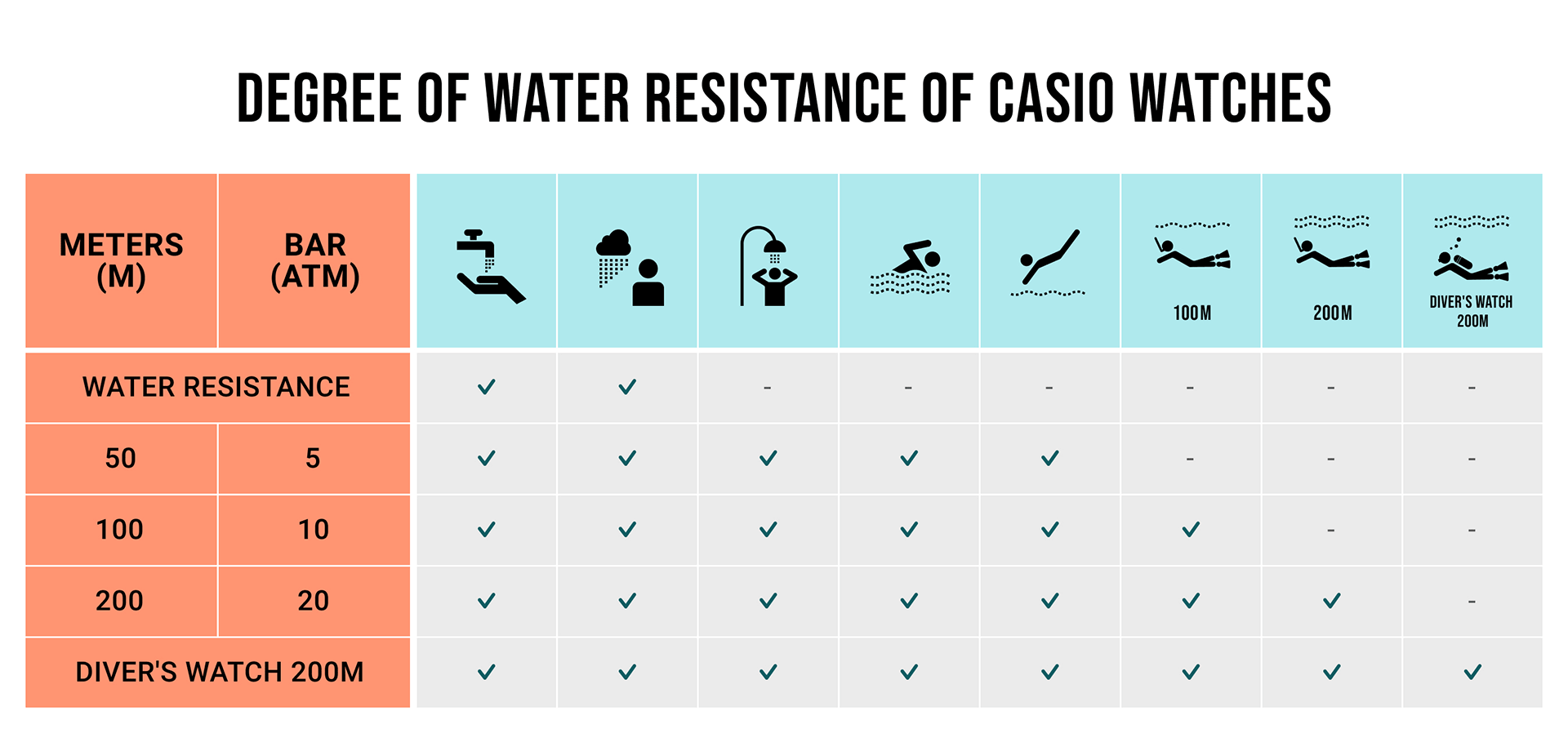Water resistance in watches is an essential feature that ensures your timepiece can withstand exposure to water without damage. Whether you're swimming, diving, or simply washing your hands, knowing what ATM water resistance means is crucial for protecting your watch. This article will delve into the details of ATM water resistance and help you make informed decisions about your timepiece.
Many people assume that water resistance is a standard feature in all watches, but this is far from the truth. Different watches have varying levels of water resistance, measured in ATM (atmospheres). Understanding what ATM means and how it applies to your watch can significantly enhance its longevity and performance.
In this guide, we will explore the concept of ATM water resistance, how it works, and the factors that influence its effectiveness. By the end of this article, you will have a thorough understanding of ATM water resistance and how it impacts your watch's durability.
- Mkpoint Movies Download Your Ultimate Guide To Legal And Safe Movie Streaming
- Discover The Ultimate Movie Experience With Movie 4hd Hub
Table of Contents
- What is ATM Water Resistance?
- How Does ATM Water Resistance Work?
- ATM vs. Bar: Understanding the Differences
- ATM Levels and Their Applications
- Choosing the Right ATM Level for Your Needs
- Maintaining Water Resistance in Watches
- Common Mistakes to Avoid with Water Resistance
- Testing Water Resistance: What You Need to Know
- Factors Affecting Water Resistance
- Conclusion
What is ATM Water Resistance?
ATM water resistance refers to the ability of a watch to withstand water pressure at a specific depth. The term ATM stands for "atmospheres," which is a unit of measurement that indicates how much pressure a watch can endure. One ATM is equivalent to 10 meters of water pressure, making it a useful metric for determining a watch's water resistance.
It is important to note that ATM water resistance does not mean a watch is completely waterproof. Instead, it signifies the watch's ability to resist water ingress under specific conditions. For example, a watch rated at 10 ATM can withstand water pressure up to 100 meters, but it does not guarantee it can be used for deep-sea diving.
The History of ATM Water Resistance
The concept of water resistance in watches dates back to the early 20th century when manufacturers began developing watches that could withstand exposure to water. Initially, water resistance was limited to basic splash protection, but advancements in technology have enabled watches to achieve higher ATM ratings.
- Prmoviesreport Your Ultimate Guide To Streaming Movies Online
- Sd Movie Point Hub Your Ultimate Guide To Streaming And Downloading Movies
Today, ATM water resistance is a standard feature in most watches, with varying levels designed to meet different user needs. From casual wear to professional diving, understanding ATM water resistance is essential for selecting the right watch for your lifestyle.
How Does ATM Water Resistance Work?
ATM water resistance works by using a combination of materials, design, and engineering to create a watertight seal around the watch. This includes:
- Gaskets: Rubber or silicone seals that prevent water from entering the watch case.
- Screw-down Crowns: Crowns that screw into the watch case, providing an additional layer of protection.
- Caseback Seals: Sealed casebacks that prevent water from penetrating the watch's internal components.
These features work together to ensure the watch remains water-resistant under specified conditions. However, it is important to note that water resistance can degrade over time due to wear and tear, requiring regular maintenance to maintain its effectiveness.
ATM vs. Bar: Understanding the Differences
While ATM is the most commonly used unit of measurement for water resistance, some manufacturers use the term "bar" instead. One bar is equivalent to 1 ATM, making it easy to compare the two measurements. However, it is important to understand the context in which these terms are used.
For example, a watch rated at 5 ATM is the same as a watch rated at 5 bar. Both indicate the watch can withstand water pressure up to 50 meters. However, the terminology used can vary depending on the manufacturer and region.
ATM to Bar Conversion
Here is a quick conversion chart for ATM and bar:
- 1 ATM = 1 bar = 10 meters
- 3 ATM = 3 bar = 30 meters
- 5 ATM = 5 bar = 50 meters
- 10 ATM = 10 bar = 100 meters
Understanding this conversion can help you make informed decisions when purchasing a watch with water resistance.
ATM Levels and Their Applications
ATM levels vary depending on the intended use of the watch. Here are some common ATM levels and their applications:
3 ATM (30 Meters)
A watch rated at 3 ATM is suitable for everyday use and can withstand splashes of water, such as rain or handwashing. However, it is not recommended for swimming or prolonged exposure to water.
5 ATM (50 Meters)
A watch rated at 5 ATM is ideal for light water activities, such as swimming in shallow water. It provides greater water resistance than 3 ATM but is not suitable for diving or high-pressure water exposure.
10 ATM (100 Meters)
A watch rated at 10 ATM is designed for recreational water activities, including swimming and snorkeling. It offers excellent water resistance and is suitable for most water-related activities.
20 ATM (200 Meters)
A watch rated at 20 ATM is built for professional diving and can withstand water pressure at depths of up to 200 meters. It is the preferred choice for divers and individuals who frequently engage in water sports.
Choosing the Right ATM Level for Your Needs
Selecting the right ATM level depends on your lifestyle and the activities you engage in. Consider the following factors when choosing a watch:
- Frequency of Water Exposure: How often do you expose your watch to water?
- Type of Activities: Do you swim, dive, or participate in water sports?
- Climate: Do you live in a humid or rainy environment?
By evaluating these factors, you can determine the appropriate ATM level for your needs and select a watch that meets your requirements.
Maintaining Water Resistance in Watches
To ensure your watch remains water-resistant, it is essential to maintain its seals and components. Here are some tips for maintaining water resistance:
- Regular Checkups: Have your watch checked annually by a professional to ensure its water resistance is intact.
- Avoid Extreme Temperatures: Exposure to extreme temperatures can damage the seals and compromise water resistance.
- Proper Storage: Store your watch in a cool, dry place when not in use.
Following these maintenance tips can help prolong the life of your watch and ensure its water resistance remains effective.
Common Mistakes to Avoid with Water Resistance
Many people make mistakes when it comes to water resistance, leading to damage or malfunction of their watches. Here are some common mistakes to avoid:
- Assuming Water Resistance is Permanent: Water resistance can degrade over time, requiring regular maintenance.
- Exposing the Watch to High Pressure: Avoid exposing your watch to high-pressure water, such as from a showerhead or jet spray.
- Using the Watch Beyond Its Rated Depth: Do not use your watch beyond its specified ATM level, as this can lead to water ingress.
Avoiding these mistakes can help protect your watch and ensure it remains functional for years to come.
Testing Water Resistance: What You Need to Know
Testing water resistance involves subjecting the watch to controlled conditions to determine its ability to withstand water pressure. This is typically done by professional watchmakers using specialized equipment. Here are some key points to consider:
- Professional Testing: Have your watch tested by a professional to ensure accurate results.
- Regular Testing: Test your watch annually to ensure its water resistance remains effective.
- Understanding Test Results: Understand the results of the test and take appropriate action if necessary.
By testing your watch regularly, you can identify potential issues and address them before they cause damage.
Factors Affecting Water Resistance
Several factors can affect the water resistance of a watch, including:
- Seal Degradation: Over time, seals can degrade, reducing water resistance.
- Temperature Fluctuations: Exposure to extreme temperatures can damage seals and compromise water resistance.
- Impact and Wear: Physical impact or wear can damage the watch's case and reduce water resistance.
Understanding these factors can help you take proactive steps to maintain your watch's water resistance and prevent damage.
Conclusion
In conclusion, ATM water resistance is a critical feature in watches that ensures they can withstand exposure to water without damage. By understanding ATM levels, their applications, and how to maintain water resistance, you can select the right watch for your needs and ensure its longevity.
We encourage you to share your thoughts and experiences in the comments below. If you found this article helpful, please consider sharing it with others. For more informative content, explore our other articles on watches and accessories.
- Mkvin Bollywood The Rising Star Revolutionizing The Indian Film Industry
- Hdb4uhub A Comprehensive Guide To Your Housing Needs


